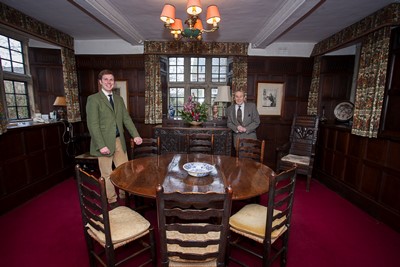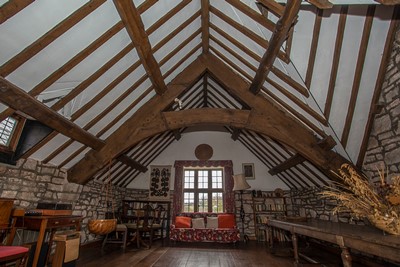
One of North Wales’s most historic houses, with links to Owain Glyndwr and ‘The Fighting Morgans’ of the English Civil War, is on the market for three-quarters of a million pounds.
Henblas, an imposing sandstone home in an acre of grounds in the village of Llanasa, is a rare Grade One-listed building which even has its own resident ghost.
A spectral coach and horses is reputed to occasionally clatter through the gateway to the house which was built almost 370 years ago, in 1645, in the midst of the Civil War.
It is for sale with Jones Peckover, one of North Wales’s longest-established estate agents and auctioneers who market a range of properties across North Wales and the Border Counties from offices in Wrexham, Denbigh, Abergele and Menai Bridge.
Their Denbigh office property specialist Matthew Holmberg, said: “Henblas is a magnificent building which is probably the finest in a village which itself has a wealth of historic properties.
“It is quite exceptional and stands in about an acre of beautiful landscaped gardens and has a two-storey barn with a workshop and double garage.
“It has a rich and wonderful history but it is still a lovely house to live in.”
That echoes the thoughts of owners David Lawton and his wife, Bridget, who have owned the property for 40 years and brought up their five children there.
He said: “We were married 60 years ago in the church in the village but I knew it before then because I was born in Prestatyn and used to cycle up here.
“It was built for the Morgan family of Golden Grove at the time of the Civil War and actually during the siege of Chester.
“It has a wonderful history which includes having been used to house German prisoner of war officers in the First World War and evacuees in the Second World War.
“At one time it’s been owned by the Mostyn family and also by Dennis Vosper MP, Lord Runcorn, who really restored the property in the 1960s after it had fallen into some disrepair.
“We’ve been happy here and it’s been a lovely home and easily maintained. It’s compact and doesn’t ramble but it’s just a bit too big for the two of us now.”
Lord Runcorn was an old boy of Marlborough College, an exclusive pubic school whose former pupils also include the Duchess of Cambridge, Samantha Cameron, the wife of the Prime Minister, John Betjeman, comedian Jack Whitehall and Mark Phillips.
He even bought several oak tables from the College and used them to re-floor the spectacular hall room on the second floor which is over 40 feet long and more than 17 feet wide and features massive oak cross beams and where one refectory table still survives.
Another notable local resident was Dr Edwin Parry, who lived there in the 19th century and is buried in the churchyard – he lost both legs in a railway accident but continued to practice from the house.
Matthew Holmberg added: “There are a number of interesting features to the house which has three floors and a cellar including a carving of a man and a woman above the front door and also some more interesting carving on one of the gable ends.
“There is a verse in Old Welsh near the foot of the exterior wall while at the top there is a carving of a kneeling figure with the date of the house’s construction.
“It all adds up to making this a fascinating property and one of the most unusual – these sorts of historic houses don’t come on the market very often.
“Inside there is some wonderful wood panelling in the dining room, a magnificent oak staircase and a series of spacious rooms, including at least five bedrooms.
“The house was added to later and there is also a separate lodge which dates from slightly later in the 17th century which is also for sale.”
Local historian Paul Parry believes the house may also have a link to Owain Glyndwr. He said: “The verse in Old Welsh means ‘I grew trees round thee to get thee ready for me’ and is attributed to Gruffudd Fychan, Owain Glyndwr’s father.
“He is buried in the Church and it is believed he could have lived here in the 14th century in an older building which would have been demolished with Henblas built on its foundations.
“The house was built for the marriage of a daughter of the Mostyn family of Talacre and one of the Morgans, from nearby Golden Grove, probably one of the fighting Morgans who all died in the service of the Royalist cause.
“The figures above the front door are probably the couple and on the gable end there’s a carved kneeling figure with a scroll coming from his mouth and a Latin text.
“There was a belief that the Morgan who owned the house was the famous pirate Henry Morgan but that’s not the case, he was from South Wales though that didn’t stop someone from digging up the grave of the local Morgan looking for the pirate treasure.
“It could be the Morgan who is commemorated on the walls of Chester with Morgan’s Mount, a gun emplacement named after either Captain William Morgan or his son, Edward.
“There’s also said to be a tunnel which leads from the cellar at Henblas across the road and from looking at the ground there does seem to be something underground and if it’s only a drain then it’s a very big one.”
For more information go to http://www.jonespeckover.co.uk/

